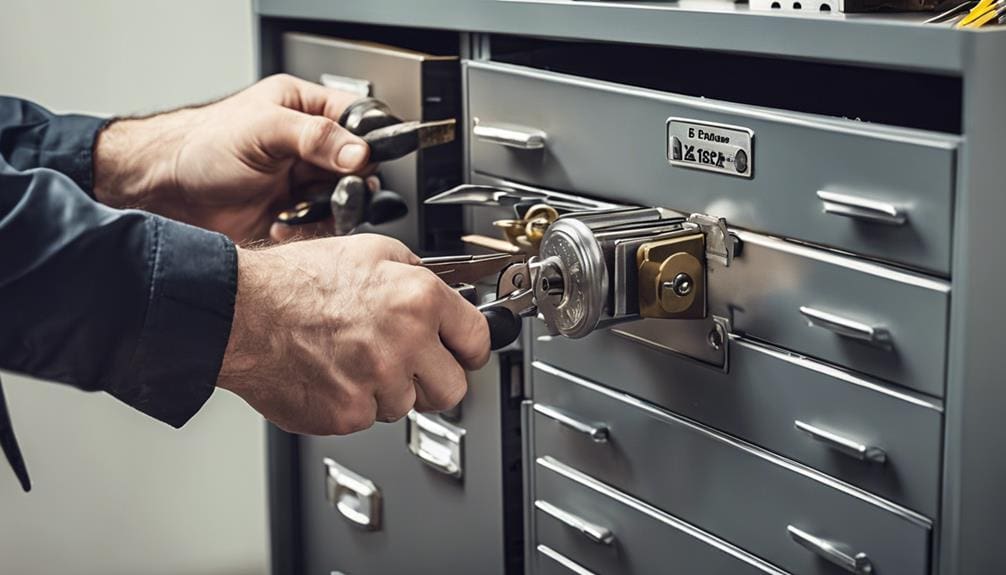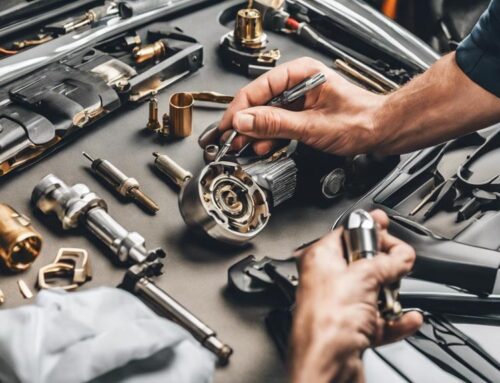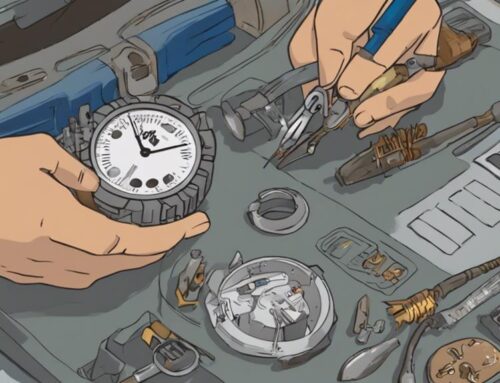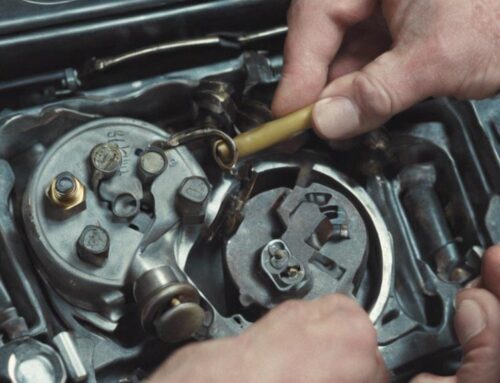Yes, a locksmith can open your locked filing cabinet quickly and efficiently. They use non-destructive methods, such as lock picking, to access the cabinet without causing any damage. If you’ve lost your keys or have a jammed lock, professional locksmiths can craft replacement keys or realign the lock components. Their expertise guarantees minimal disruption, allowing you to regain access to important documents without hassle. Trusting a locksmith also means maintaining the security and integrity of your filing cabinet. For more detailed insights on what a locksmith can do for your locked filing cabinet, explore further.
Key Takeaways
- Professional locksmiths can efficiently open locked filing cabinets using non-destructive techniques.
- Locksmiths utilize specialized tools to ensure the lock and cabinet remain undamaged.
- They provide urgent response services to help access important documents quickly.
- Locksmiths can replace or rekey the lock if necessary for enhanced security.
- Engaging a locksmith minimizes disruption and ensures a seamless return to tasks.
Locksmith Services for Filing Cabinets
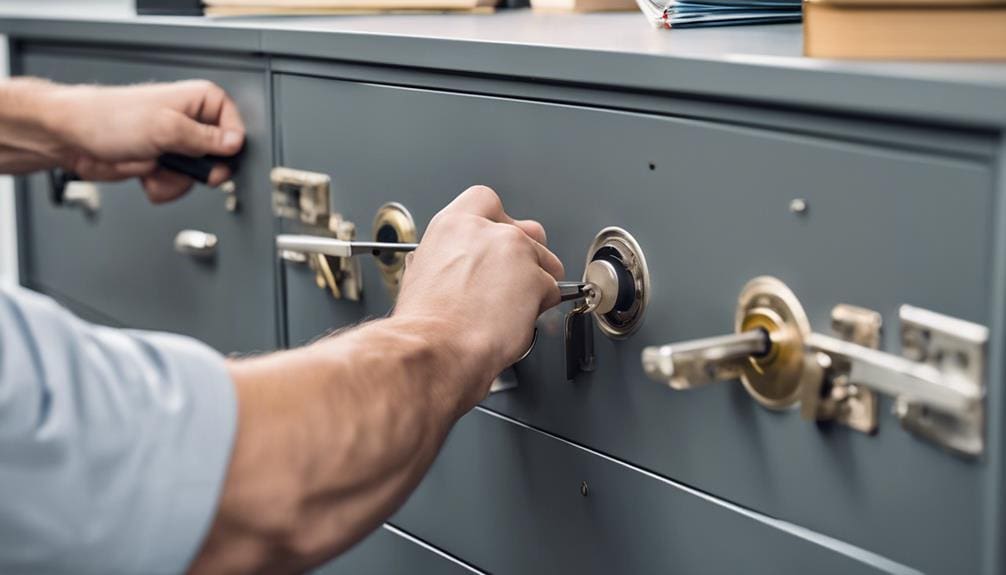
When you’re locked out of your filing cabinet, locksmith services provide a professional and efficient solution to regain access. A locksmith can create a new key or pick the file cabinet lock without causing damage, guaranteeing you maintain the integrity of your storage. Their expertise allows for non-destructive methods, making it a safe and reliable option. Additionally, locksmiths can replace the lock if necessary, offering quick and cost-effective solutions. They understand the urgency of accessing important documents and respond promptly to your needs. By hiring a professional locksmith, you secure minimal disruption and a seamless return to your tasks, ultimately enhancing your ability to serve others effectively.
Common Filing Cabinet Lock Issues
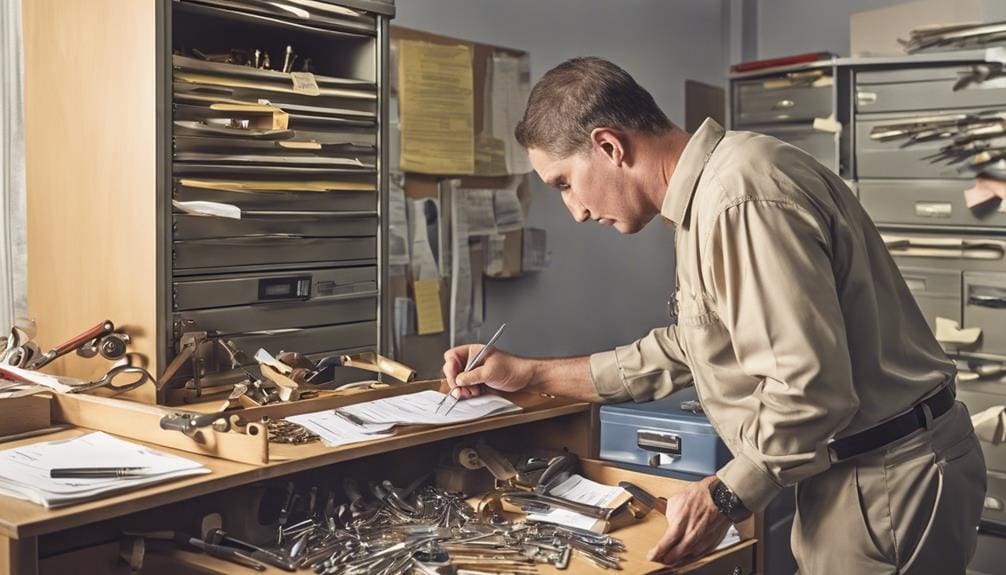
You might face common filing cabinet lock issues such as lost or broken keys, or jammed mechanisms. These problems can disrupt your access to important documents and hinder your workflow. A professional locksmith can efficiently address these issues using specialized tools and expertise.
Lost or Broken Keys
Losing or breaking the keys to your filing cabinet can be a significant inconvenience, but a locksmith can efficiently resolve this issue with their specialized key replacement services. Their expertise guarantees that your file and cabinet remain undamaged while they access the lock. Locksmiths use non-destructive methods and can either create new keys, make the current key fit, or pick the lock to help you regain access. Here’s how they can help:
- Key Replacement: Create new keys to replace lost or broken ones.
- Key Adjustment: Modify existing keys to fit the lock.
- Lock Picking: Open the lock without damaging the cabinet.
- Professional Service: Guarantee the process is safe and efficient.
Relying on a professional locksmith is the safest and most effective solution for dealing with lost or broken keys.
Jammed or Stuck Locks
A jammed or stuck lock in a filing cabinet often stems from debris, dust, or misaligned internal components, and addressing these issues requires professional expertise. When you encounter a locked filing cabinet with such problems, forcing it open can cause further damage. Instead, a locksmith can diagnose the issue, whether it’s debris or worn-out key pins, and provide a safe solution. They may lubricate the mechanism or adjust the key pins to restore functionality.
| Issue | Cause | Solution |
|---|---|---|
| Jammed Lock | Debris or Dust | Professional Cleaning |
| Stuck Lock | Misaligned Components | Realignment by a Locksmith |
| Worn-out Key Pins | Wear and Tear | Key Pin Adjustment |
| Damaged Lock Mechanism | Forcing Open | Professional Repair |
| Preventive Maintenance | Lack of Lubrication | Regular Locksmith Check-ups |
Seeking assistance from a locksmith guarantees your locked filing cabinet is handled safely and effectively.
Professional Lock Picking Techniques
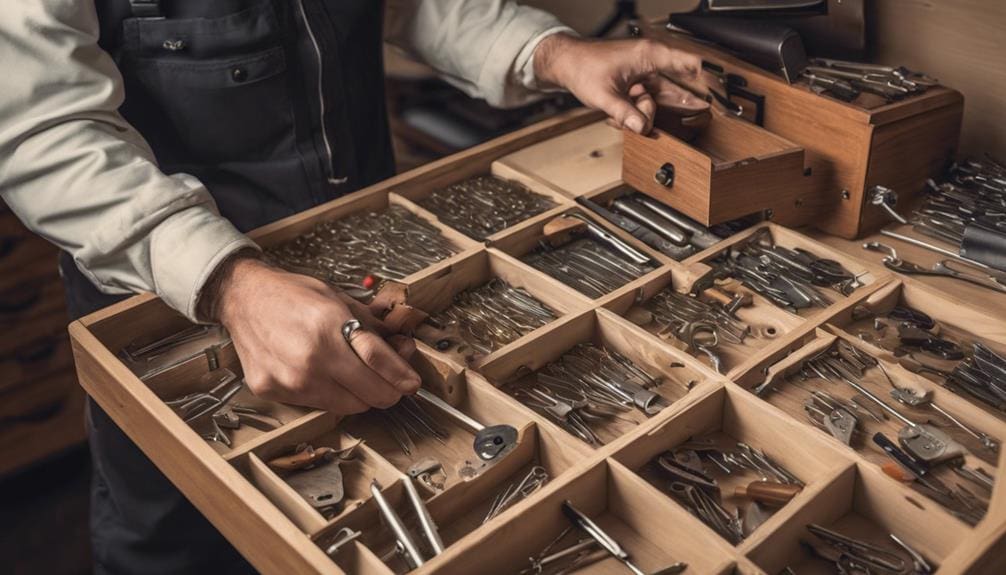
To understand professional lock picking techniques, you’ll need to know about essential locksmith tools, non-destructive entry methods, and advanced picking techniques. Locksmiths use specialized tools like tension wrenches and pick sets to manipulate lock components without causing damage. By mastering these techniques, they can efficiently and safely open your filing cabinet.
Essential Locksmith Tools
Professional locksmiths rely on specialized tools like lock picks and tension wrenches to expertly open secured filing cabinets. These tools, combined with their training in key and lock picking techniques, enable locksmiths to handle a variety of locks efficiently. They can access secured filing cabinets without needing the original key, ensuring minimal damage to your property.
Essential tools in a locksmith’s arsenal include:
- Lock picks: Used to manipulate the pins within the lock.
- Tension wrenches: Provide the necessary torque to turn the lock.
- Key extractors: Remove broken keys trapped inside the lock.
- Plug spinners: Rotate the plug to the secured position after picking.
With these tools, locksmiths can serve you effectively and safely.
Non-Destructive Entry Methods
Locksmiths employ non-damaging entry methods, such as expert lock picking techniques, to access sealed filing cabinets without harming them. By using specialized tools and their extensive training, locksmiths can efficiently pick the lock of a file cabinet. This ensures that the cabinet remains intact and fully operational after it is accessed. Professional lock picking is a safe and effective way to gain entry, making it an ideal solution for those who need access to important documents while preserving the integrity of their office furniture. Relying on a locksmith’s expertise in non-damaging methods not only saves you from costly repairs but also maintains the security and usability of your file cabinet.
Advanced Picking Techniques
Mastery of advanced picking techniques allows locksmiths to manipulate the intricate mechanisms of filing cabinet locks with precision and efficiency. By using specialized tools and skills, locksmiths can make a slight adjustment to the lock tumblers, effectively accessing the cabinet without causing any damage.
Professional locksmiths employ these advanced techniques to:
- Preserve the integrity of the filing cabinet remains intact.
- Open locked filing cabinets quickly, minimizing disruption.
- Choose the most effective method based on in-depth knowledge of different lock types.
- Utilize non-destructive methods to maintain the cabinet’s condition.
With these techniques, a locksmith can efficiently address your needs, ensuring your filing cabinet locks are opened securely and without harm. This expertise guarantees that your valuables remain protected and accessible.
Key Replacement Solutions

When you misplace your file cabinet key, a locksmith can promptly craft a replacement, even if the manufacturer can’t provide one right away. Locksmiths possess the expertise to cut a new key or pick the lock to gain access efficiently. This professional approach ensures you don’t have to resort to potentially damaging methods.
Here’s a quick look at what locksmiths can do for you:
| Service | Benefit | Time Frame |
|---|---|---|
| Key Cutting | Exact replacement key | Within moments |
| Lock Picking | Non-destructive entry | Immediate access |
| Lock Rekeying | Enhanced security | Short duration |
Engaging a locksmith for key replacement is a swift, secure, and non-destructive solution to misplaced file cabinet keys.
Importance of Non-Destructive Entry
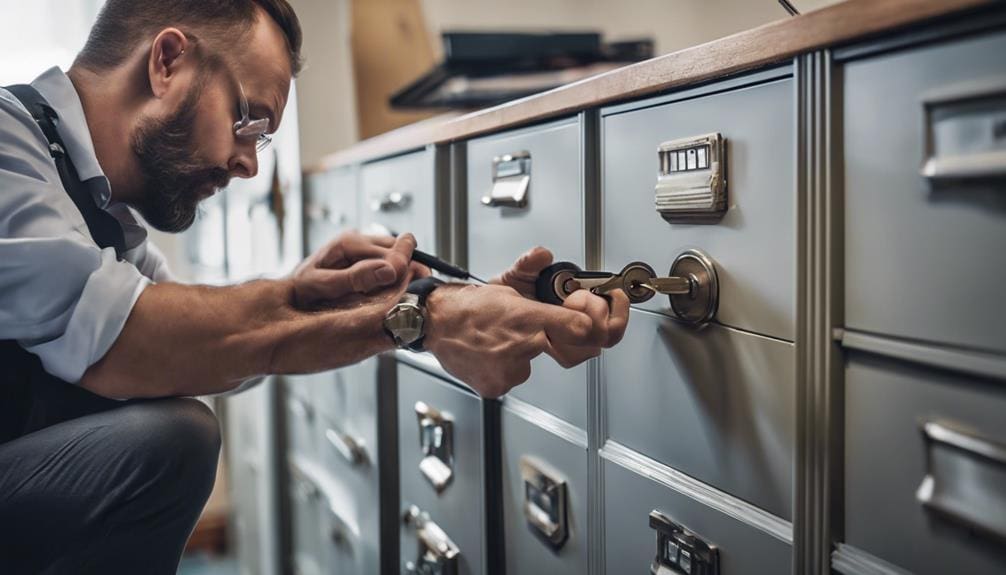
Utilizing non-damaging entry methods safeguards your filing cabinet remains intact and functional while accessing its contents. Locksmiths specialize in such techniques, guaranteeing the locked filing cabinet isn’t harmed during the process. This approach is crucial for maintaining the integrity of your furniture and safeguarding important documents.
Benefits of non-damaging entry include:
- Preservation of Cabinet: No physical harm ensures longevity.
- Cost-Efficiency: Avoids the expense of replacing or repairing the cabinet.
- Security: Maintains the original security features of the locked filing cabinet.
- Professional Expertise: Locksmiths use specialized tools and skills for safe access.
Smart Lock Upgrades
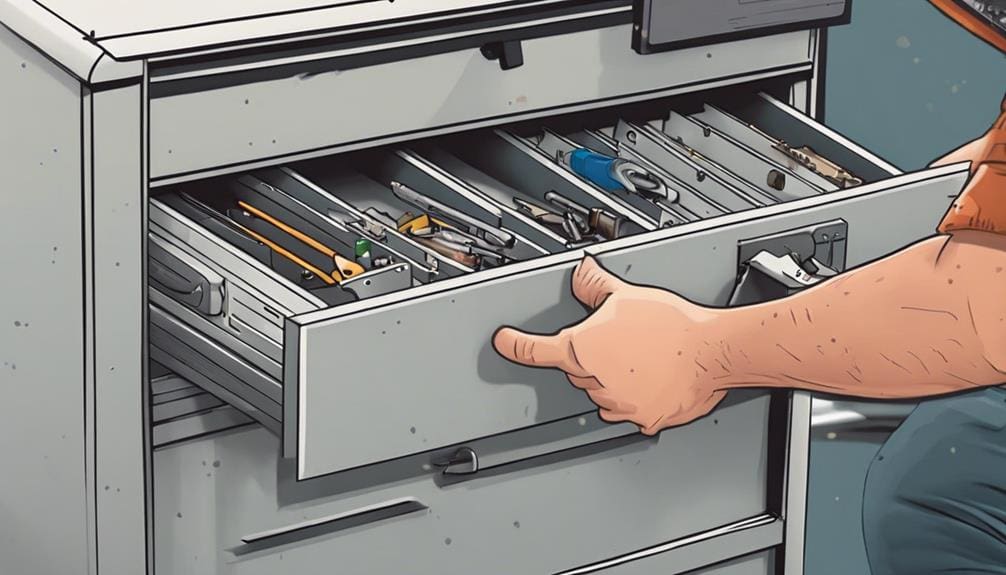
Smart lock upgrades provide enhanced security and convenience by allowing remote access and monitoring through smartphone apps. They eliminate the need for physical keys, reducing the risk of key loss or unauthorized duplication. With smart lock upgrades, you can grant temporary access to others, guaranteeing excellent customer service for clients or guests. The technology addresses vulnerabilities found in traditional locks, offering robust protection against unauthorized access. Assure your filing cabinet remains secure by selecting a smart lock with reliable technology and implementation. By integrating these advanced features, you’re providing a higher level of security and demonstrating a commitment to safeguarding sensitive information. Smart lock upgrades not only enhance security but also streamline access management, benefiting both you and those you serve.
Preventing Future Key Loss
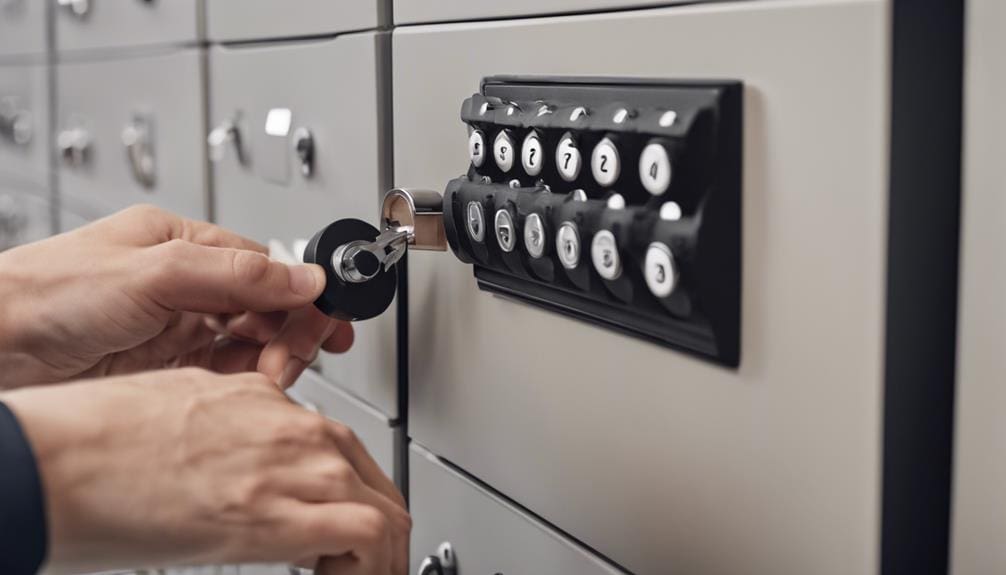
To prevent future key loss, keep spare keys in a secure and easily accessible location. This can save you from the frustration and downtime associated with a lost file cabinet key. Here are some practical steps:
- Have a locksmith create duplicate keys: This guarantees you always have a backup.
- Distribute spare keys to trusted individuals: Adds another layer of security.
- Store spare keys in a labeled key box: Easy to find when needed.
- Proactively duplicate keys periodically: Averts issues if you lose or break one.
Spare Key Management
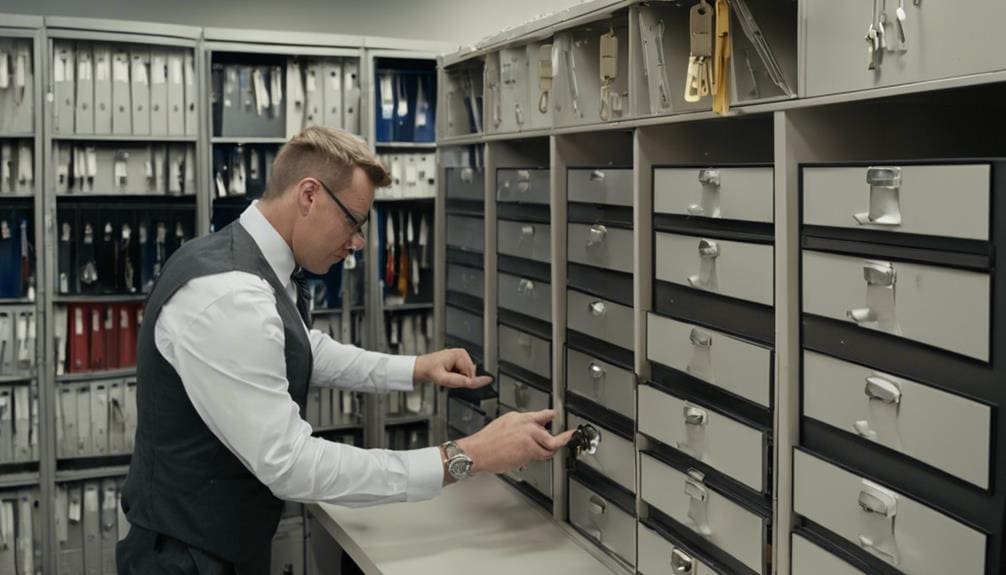
Effective spare key management guarantees you always have access to your filing cabinet, even in unexpected situations. By keeping spare keys in a secure location known only to you, you prevent unauthorized access while ensuring you can retrieve them when needed. Duplicate keys made by a professional locksmith offer added security and accuracy. This proactive approach to spare key management means you won’t face lockout situations due to key loss or damage. Properly managing and storing spare keys is essential for maintaining seamless access to important documents and files. Avoid the risk of being locked out by regularly checking and updating your spare key inventory, ensuring you’re always prepared for any eventuality.
Contact Low Rate Locksmith
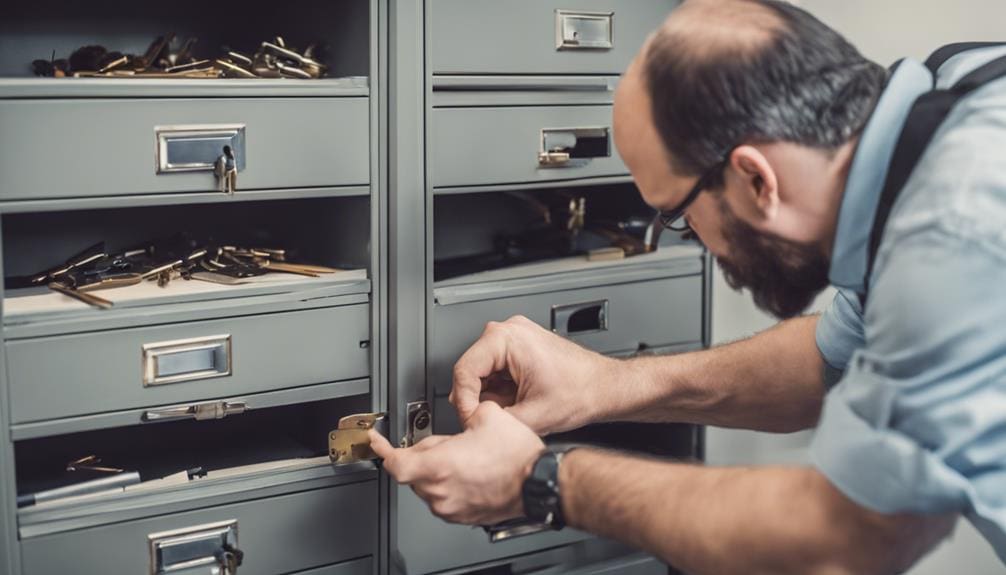
When you’re faced with a locked filing cabinet, reaching out to Low Rate Locksmith promises swift and efficient access without causing damage. Their professional services secure your cabinet is opened promptly and securely. Here’s why you should consider them:
- Expertise: Their skilled locksmiths are proficient at handling various types of file cabinet locks.
- Quick Response: They offer fast response times to assist you promptly.
- Non-Destructive Methods: They employ non-damaging techniques to access your locked filing cabinet.
- Versatility: Whether dealing with traditional or digital locks, they’ve got you covered.
Frequently Asked Questions
Can a Locksmith Open a Filing Cabinet?
Yes, a locksmith can open a filing cabinet for you. They’re equipped with the expertise and tools needed to create a new key, adjust the current key, or pick the lock. By hiring a locksmith, you guarantee a non-destructive and efficient method to access your cabinet, preserving its integrity. It’s a quick, professional solution that saves you time and hassle, preventing any potential damage from attempting to force it open yourself.
How to Unlock a Locked File Cabinet?
Opening a secured file cabinet is like cracking a safe; it requires precision and expertise. You should call a locksmith who can use specialized tools and techniques to open it efficiently. They can pick the lock, create a new key, or even replace the lock if necessary. Attempting it yourself might damage the cabinet. Trusting a professional guarantees a non-destructive and effective solution, keeping your cabinet intact.
How to Open a Stuck Filing Cabinet?
To access a stuck filing cabinet, start by applying gentle pressure to the drawers while securing. Lubricate the lock with graphite powder to ease the mechanism. Check for obstructions or debris in the keyway. Use a spare key if available. If these methods don’t work, contacting a professional locksmith guarantees proper handling and avoids potential damage. This approach serves your needs efficiently and professionally.
How to Remove a Lock From a Filing Cabinet?
To remove a lock from a filing cabinet, start by locating and unscrewing the screws securing it. Use a screwdriver and carefully detach the lock. Watch for additional components like clips or fasteners that may need removal. Keep track of all parts for reassembly. If the lock is intricate or you encounter difficulties, don’t hesitate to seek help from a locksmith to guarantee proper removal and avoid damage.

